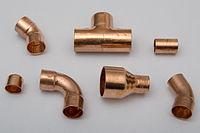
Photo from wikipedia
Blockages in piping systems are formed from potentially complex combinations of bio-film build up, corrosion by-products, and sediment deposition. Transient-based methods seek to detect blockages by analyzing the evolution of… Click to show full abstract
Blockages in piping systems are formed from potentially complex combinations of bio-film build up, corrosion by-products, and sediment deposition. Transient-based methods seek to detect blockages by analyzing the evolution of small amplitude pressure waves. In theory, such methods can be efficient, nearly non-intrusive and economical but, thus far, studies have only considered symmetrical blockages, uniform in both the radial and longitudinal directions. Laboratory experiments are described here that involve pipe blockages with various levels of irregularity and severity; the way the transient response is affected by a non-uniform blockage is investigated. The differences between uniform and non-uniform blockages are quantified in terms of the rate that wave envelopes attenuate and the degree that phases are shifted. Two different methods for modeling these impacts are compared, namely through an increase in pipe roughness and through a wave scattering model. Wave scattering is shown to play a dominant role in explaining both wave envelope attenuation and phase shift. The accuracy of existing transient-based methods of blockage detection in the frequency domain is also examined, and is found that the predictions of rough blockage locations and sizes by current method are in good agreement with data, with relatively larger discrepancies for rough blockage lengths.
Journal Title: Journal of Hydro-environment Research
Year Published: 2017
Link to full text (if available)
Share on Social Media: Sign Up to like & get
recommendations!